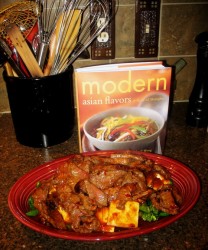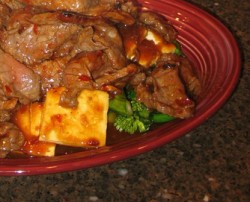Book Review: Modern Asian Flavors
Most of my current focus in building a library of Chinese cookbooks has been on out-of-print or difficult to find volumes. However, now and again, a new cookbook comes out that I find to be intriguing, so I pick it up and see what it is about.
Modern Asian Flavors: A Taste of Shanghai, by Richard Wong, is one such book.
Richard Wong, a native of Shanghai who grew up in the United States, is the founder and owner of chinablue, a company which creates a line of popular Shanghainese sauces, oils, glazes and dressings which are sold in upscale markets, gourmet stores and groceries around the country.
I am actually glad that I didn’t know this when I picked up the book and looked at some of the recipes; I would have assumed that the book was just a means by which Wong meant to market his sauces, but none of the recipes feature his bottled products. Instead, instructions are given on how to make basic sauces, dressings and glazes from scratch to use in creating the later recipes.
I don’t know much about Shanghainese foods, except to say that Shanghai, which was once a city that was populated by Chinese, European, Indian and Japanese people, and as such, the food of Shanghai has always shown a very global influence. I have grown to understand that Shanghainese food often uses a great deal of sugar, and as such, many of the dishes common to the region have a strong sweetness to them. Other strong flavors are used to compliment the sweetness: soy sauce, sesame oil, black beans, scallions and red chile paste are used copiously in many of the recipes in this book.
The one thing I really didn’t like about the book was the way the recipes were written. There is not much emphasis on technique and proper stir-frying in the book, and I think that is a definate lack when it comes to a book presenting Chinese food to an American audience. Granted many of these dishes are fusions of Chinese flavors with European techniques or ingredients, but still–I think that any really good Chinese or other Asian cookbook should delve deeply into technique when they are aimed at a Western audience–simply because the techniques used in each cuisine are so different.
A plus on the side of the book was the beautiful food photography by Noel Barnhurst. The photographs are spare, with delicately arranged foodstuffs presented on dinnerware of muted colors. The food itself, often vividly hued, is the centerpiece, and the backgrounds fade into soft focus, allowing the brilliant tones and linear shapes of red and yellow peppers, for example, to draw the reader’s eye effortlessly.
The proof of any cookbook, however, is in the recipes, and judging by Zak’s reaction to the one recipe I have tested from Modern Asian Flavors so far, I think that this book “has the stuff” to be considered a worthy addition to my Chinese cookbook collection. However, I have to say that I didn’t follow the recipe exactly for the dish, because even though it is billed as a stir-fry, the instructions as written, which require that the cook put marinated meat and a half-cup of sauce into the wok and “stir-fry” it, would not result in either the flavor or texture of stir-fried meat. It would result in quick-braised meat–which would have a totally different texture and flavor.
I also added a layer of gai lan simply stir fried in peanut oil to the dish, so as to have a more complete one-dish meal.
The final change that I made was to the Shanghainese Red Pepper Sauce, which one makes before making the rest of the dish. The original recipe called for 1/2 cup of sugar dissolved in a 1/4 dry sherry (I used shao hsing wine, needless to say), six tablespoons of soy sauce, and two teaspoons of sesame oil to which two tablespoons of chile garlic paste and shredded ginger have been added.
I found that the sweetness was overpowering until I added a further two and a half tablespoons of chile garlic paste. Once the heat balanced the sweetness, however, the sauce was divine. Zak informed me that I would be making this particular dish again, and hopefully soon.
Red Pepper Beef and Tofu Stir Fry
Ingredients for Shanghainese Red Pepper Sauce:
2 teaspoons cornstarch
6 tablespoons soy sauce
1/2 cup sugar
1/4 cup shao hsing wine
2 tablespoons chile garlic paste (or 4 1/2 tablespoons as I made it)
2 tablespoons finely grated fresh peeled ginger
2 teaspoons toasted sesame oil
(You are supposed to cook this sauce; however, I didn’t do that–I saw no reason to cook it twice, as I was using right away in a cooked dish.)
Ingredients:
(Optional: 1 pound young gai lan, washed, trimmed and cut into 2″ long chunks–this was my own addition)
12 ounces bomless rib-eye steak, trimmed of fat and cut into 1/8 inch thick slices across the grain (I used top sirloin)
2 tablespoons cornstarch (again, this is my addition)
1 cup Shanghainese red pepper sauce, divided
1/2 cup plus two tablespoons peanut oil (I used 6 tablespoons of oil total–the half cup to fry the tofu was unecessary)
14 ounces extra firm tofu, cut into 2 inch squares that are 1/4 inch thick
Method:
Toss beef with 1/2 cup of the pepper sauce, and the two tablespoons of cornstarch. Set aside for at least twenty minutes.
If you are using the gai lan, heat wok, and when it smokes, add 2 tablespoons of peanut oil. Add gai lan, and stir fry until the stems are tender crisp and the leaves are wilted and velvety. Scoop out of wok onto a warmed serving platter, and spread the greens evenly over bottom of platter.
Heat wok again, add 2 tablespoons of oil, and lay tofu squares into wok. Allow to brown on one side, flip them over, and allow to brown on the other side, stir frying carefully so as to not break the tofu apart. Scoop out of wok and layer browned tofu on top of gai lan.
Heat wok again, add the remaining oil, and then add meat. Leave any liquid marinade in the bowl and reserve it. Allow meat to brown on the one side about one minute before turning and flipping and stir-frying. After cooking for about a minute, add the marinade from the bowl and the rest of the sauce, and cook, until the meat is medium rare and the sauce is thickened and fragrant. Pour contents of wok over tofu and gai lan and serve immediately with plenty of steamed rice.
2 Comments
RSS feed for comments on this post.
Sorry, the comment form is closed at this time.
Powered by WordPress. Graphics by Zak Kramer.
Design update by Daniel Trout.
Entries and comments feeds.





Just lovely…too lovely
Comment by Tony — March 25, 2006 #
Thank you, Tony. It really is a pretty presentation–and an unusual one in that it mixes different shapes. Most Chinese styled recipes try to keep the ingredient shapes analogous. The square slices of tofu looked neat contrasting with the rectangular slices of the beef.
Comment by Barbara — March 27, 2006 #